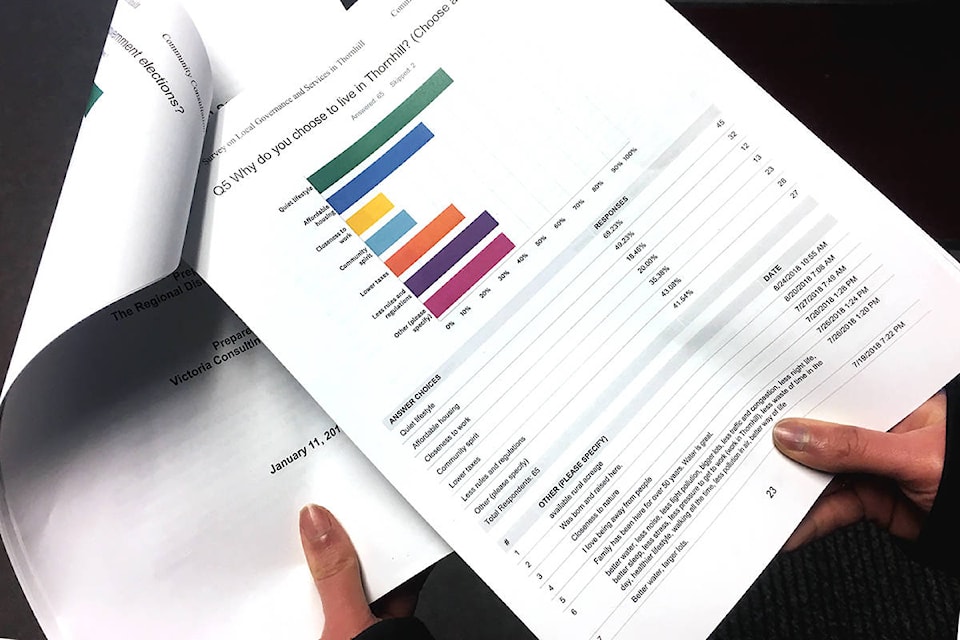The Regional District of Kitimat-Stikine (RDKS) stopped its Thornhill Governance Study from proceeding to the second stage due to an underwhelming amount of public input.
The RDKS launched their community outreach program mid-June last year to hear from Thornhill residents and businesses whether they would like to explore other options of governance. Only five per cent of approximately 3,100 adults engaged.
“There was no demonstration that the community wanted us to look at different governance options at this time,” says Ted Pellegrino, RDKS manager of planning and development services. “That’s what the feeling is, to leave it for now and if there’s really a community motivation to look at a different governance option for Thornhill, then it can be looked at in the future.”
At stake was whether Thornhill wanted to incorporate as a municipality, amalgamate with Terrace, or remain a large unincorporated community under the governance of the regional district. The public consultation was aimed at exploring the pros and cons of each option.
Currently, Thornhill comprises its own Electoral Area within the district. Previous proposals to merge with Terrace were voted down. Most recently, Thornhill’s previous electoral director, Ted Ramsey, who is favour of incorporation, pushed to re-examine the merits of governance options.
Sixty-one Thornhill residents in a survey responded they were supportive of the study as they either believed a change should be considered or are simply interested in more information on the effects.
READ MORE: The question of Thornhill governance hits the streets — again
Funding for the community engagement process came from the Ministry of Municipal Affairs and Housing and was conducted by Victoria Consulting Network Ltd. The study took place last summer.
“Stage one was the diagnostic inventory, so we completed that and presented that to the board in 2018,” says Pellegrino. “The second stage [would be] the actual restructure study but before the province gave us the go-ahead to do that, they wanted us to undertake a consultation with the community on whether there was interest in the community to explore service delivery and governance options.”
If enough interest arose, the restructuring study would then be a two-year process that looked more thoroughly into what a governance change would result in terms of costs, tax implications and services. At the end of the second stage, it would likely result in a referendum.
The recent community outreach program included a variety of public engagement tools such as sending out newsletters, placing project posters, one-on-one interviews, two open-door sessions, two formal presentations and a survey.
At the two open door sessions, a combined total of 24 people attended.
The formal presentations saw just 44 people, while only 82 surveys were submitted.
“I would have liked to have seen 100 per cent of the numbers because at least that way you get a better sense of where the community stands in terms of whether there’s a desire to explore an alternative,” Pellegrino says. “The higher the participation level, the better. It’s like voting.”
READ MORE: What to do about Thornhill?
The interviews, in-depth discussions with residents who have a long-standing connection to Thornhill, expressed that perspectives on their governance and service delivery have not changed substantially since a 1997 referendum. The results showed many live in Thornhill for its quiet lifestyle, access to more affordable housing and less regulation compared to the City of Terrace.
But the study also revealed that the majority of respondents view their “community identity” as being strongly intertwined with Terrace.
Pellegrino says this is not unusual for communities the size of Thornhill located near a city to have this conversation throughout B.C. West Kelowna went through a similar process before becoming its own city.
“It’s common when a rural and incorporated area reaches those kinds of population numbers and it’s not like the 4,000 people are spread out over a 100-square-kilometre area — [Thornhill is] small, compact and almost the size of a municipality.”
Pellegrino adds the low numbers of participation may signify that changing governance for Thornhill is not a pressing matter for its residents at the moment. The RDKS directors voted at their regular board meeting on March 22 to re-examine Thornhill’s governance at another time as the results of the public outreach were “ambiguous.”
“This doesn’t really shut a door on it, it just kind of puts this into abeyance,” says Pellegrino.
A copy of the 100-page Thornhill Community Outreach Study is available online through the Regional District’s website.
natalia@terracestandard.com
Like us on Facebook and follow us on Twitter
